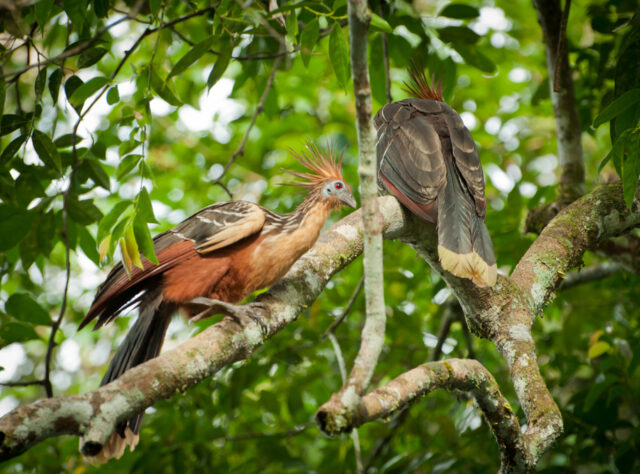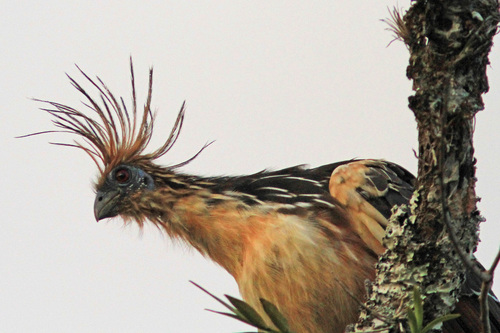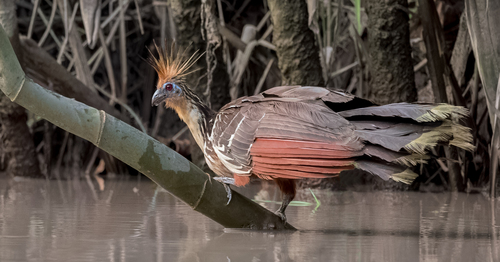
Spiky head feathers, a blue face, and a decidedly unpleasant smell – the Hoatzin. Credit: Oscar Humberto Marín-Gómez/iNaturalist
It’s not necessarily an accolade you’d want to have – the Amazon’s smelliest bird. But for the pheasant-sized Hoatzin (Opisthocomus hoazin), there isn’t much choice. Bluntly put, it reeks of manure – a fact that locals, who call it the “stinkbird”, know well. The upside of this unflattering reputation is that hunters give it a wide berth – although other predators like the Great Black Hawk (Buteogallus urubitinga) and the weasel-like Tayra (Eira barbara) are less discerning, and eat both eggs and chicks.
Why the bad smell?
The Hoatzin is an oddity in many ways. Living in the swampy backwaters of the Amazon, it only eats plants – mostly leaves but also fruits, flowers, and roots. This is a very unusual diet for a bird and the Hoatzin has a number of adaptations to handle it. Firstly, they are the only bird on Earth that ferment their food – something normally seen in ruminant mammals like cows. But while cows have a specially adapted stomach, the Hoatzin has a specially adapted crop. In most birds, the crop is used to store fairly small amounts of food – for example, to regurgitate to their chicks. But in the Hoatzin, the crop is much, much larger; so large in fact that very little room is left over for their flight muscles – something which explains their limited flying abilities.

The Hoatzin (Opisthocomus hoazin) only eats plant material. For this, it has a specialised crop that allows foregut fermentation to take place. Credit: Judy Gallagher/iNaturalist
Foregut fermentation occurs over many hours within this enlarged crop – in fact, a Hoatzin’s meal can take 45 hours to pass through its body. Since Hoatzins of course do not have teeth, they do not “chew the cud”. Rather, a mix of muscular pressure and abrasion by a “cornified” lining of the crop is used to break down vegetation. The fermented foliage releases methane which the bird expels through burping. And this – the combination of its leafy diet, foregut fermentation, and frequent burping – is why the “stinkbird” stinks.

The Hoatzin bears a striking resemblance to one of the world’s earliest bird-like dinosaurs, the Archaeopteryx. Credit: Gary Leavens/iNaturalist
A living fossil?
Hoatzin eggs look quite normal: mostly white with splotches and streaks of orange and brown. But the chick that emerges from them is very unusual. Dark brown with large eyes and, most strangely, two claws that protrude from each wing. Hoatzin chicks bear a striking, uncanny resemblance to the Archaeopteryx – a bird-like dinosaur that flew through the skies of the Late Jurassic and, like the Hoatzin, had ‘wing claws’. Could the Hoatzin be a living fossil? Do we have a dinosaur in our midst?
The Hoatzin’s relationship to other birds has long been controversial. In many ways, it is unlike anything else. For this reason, it has been far easier to say what the Hoatzin is not related to than what it is. A 2015 genetics study suggested it’s the last surviving member of an ancient bird line that branched off on its own 64 million years ago, shortly after the dinosaurs went extinct. But others disagree, with a recent study suggesting it’s not a living fossil at all and is in fact no more ancient than many other bird species alive today. The wing claws, rather than being an ancient hangover from the Jurassic, may have evolved quite recently, allowing the Hoatzin to survive in the dense Amazon jungle. Though young Hoatzins can barely fly, their claws allow them to clamber through the treetops and out of harm’s way.

The wing claws, visible here on the tip of the outstretched wing, allow young Hoatzins to climb up tree branches and to safety. This is especially helpful given that Hoatzins cannot fly for the first 70 days of their life. Credit: J. Arthur Thomson/Wikimedia Commons
Preserving this extraordinary bird
This autumn, we are asking for your support to protect the Ecuadorian Amazon, the home of the Hoatzin and many other wonderful and threatened species like the Amazon River Dolphin (Inia geoffrensis) and White-bellied Spider Monkey (Ateles belzebuth). Between 2024 and 2028, our partner Nature and Culture in Ecuador is coordinating an ambitious project to bring an estimated 747,000 hectares (1.85 million acres) of rainforest into protection. With this project, we can secure a bright future for all the inhabitants of the Ecuadorian Amazon.
You can learn more about our Protecting the Ecuadorian Amazon appeal here. Support our appeal today and help us transform the future of this incredible wildlife haven.

